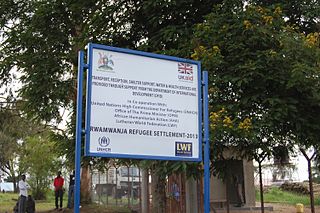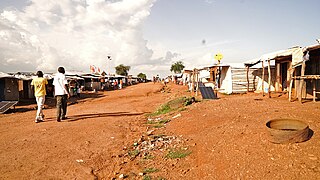Related Research Articles

Adjumani District is a district in Northern Uganda. Like most other Ugandan districts, it is named after its 'chief town', Adjumani, where the district headquarters are located.
Kiryandongo Refugee Settlement is a refugee camp in Bweyale in Kiryandongo district Uganda.

Rwamwanja Refugee Settlement is a refugee camp in Kamwenge District in southwestern Uganda and is home to nearly 70,000 refugees.

Nakivale refugee settlement is a settlement located in Isingiro District near the Tanzania border in Southwest Uganda.
Kyangwali Refugee Settlement is a refugee camp in the Kibuube District in western Uganda. April 2024, Kyangwali is home to 137,183 Refugees.

Rhino Camp Refugee Settlement is a refugee camp located in the districts of Madi-Okollo and Terego District in North Western Uganda.
Pagirinya Refugee Settlement is a refugee camp in Eastern Adjumani District in Northern Uganda.

Bidibidi Refugee Settlement is a refugee camp located in Yumbe District's West Nile sub-Region in Uganda. It is one of the world’s largest refugee settlements, housing approximately 285,000 refugees fleeing conflict in South Sudan as of late 2016. In 2017, and refugees from DR congo. it was described as the largest refugee settlement site in the world, and in 2023, it was labeled "Africa’s largest refugee camp" by The Guardian.
Imvepi Refugee Settlement is a refugee camp in Terego District in West Nile Sub Region of northwestern Uganda.
Nyumanzi Refugee Settlement is a refugee camp in Adjumani District in northwestern Uganda. Established in 2014, it hosts about 52,000 South Sudanese refugees.
The Palorinya Refugee Settlement is a refugee camp in the Moyo District of the Northern Region of Uganda. The majority of the population fled the civil crisis in South Sudan in 2016.
Oruchinga Refugee Settlement is a refugee camp in Isingiro District in Southern Uganda.
Mungula II Refugee Settlement is a refugee camp found in Adjumani District Itirikwa subcounty in Northern Uganda.
Olua I Refugee settlement is a refugee camp in eastern Adjumani District in Northern Uganda. The Refugee settlement has its primary country as Uganda and other country south Sudan.
Mungula refugee settlement is located in Adjumani district in northern Uganda on the border with South Sudan.

Boroli refugee settlement is a refugee camp located in the Pakele Sub County of Adjumani District Northern Region, of Uganda.
Ayilo 2 refugee settlement is one of the refugee camps in Adjumani District in the Northern Region of Uganda.
The Agojo refugee settlement is a refugee camp in the Adjumani District of Northern Uganda, opened in 2016 in response to an influx of South Sudanese refugees fleeing the insecurity in their country. It is located 16 kilometres (10 mi) west of the town of Adjumani.

The Maaji refugee settlements are three refugee camps located in Adjumani District in the Northern Region of Uganda, established in 1997. In June 2018, there were 41,764 registered refugees, accounting for 10% of the district's total population. It has primarily admitted refugees from the Second Sudanese Civil War and the ongoing South Sudanese Civil War. The settlements have been attacked several times by the Lord's Resistance Army, along with other camps in the region such as the Baratuku refugee settlement.
Rhino Camp Extension Refugee settlement is a refugee camp located in Omugo Zone in Arua District in Uganda. It is also known as Rhino Refugee camp - Omugo zone Extension. It hosts over 43,000 refugees. It is located next to the Imvepi Refugee Settlement.
References
- ↑ "Uganda Refugee Response Monitoring Settlement Fact Sheet: Baratuku - January 2018". January 2018.
- ↑ "Uganda Refugee Response Monitoring Settlement Fact Sheet: Baratuku (June 2018) - Uganda". ReliefWeb. Retrieved 2020-09-14.
- 1 2 "Uganda Refugee Response Monitoring Settlement Fact Sheet: Baratuku - January 2018". UNHCR Operational Data Portal (ODP) (in French). Retrieved 2020-09-20.
- ↑ A Women’s Development Magazine Published by ACFODE, A Women’s Development Magazine Published by ACFODE (2018). "A Women's Development Magazine Published by ACFODE" . Retrieved 20 September 2020.
- ↑ "Family planning helps refugees put their families, futures first". www.unfpa.org. Retrieved 2020-09-24.
- ↑ "EDUCATION CANNOT WAIT'S COMMITMENT TO REFUGEE EDUCATION". educationcannotwait. 2019-12-16. Retrieved 2020-09-20.
- ↑ "EDUCATION CANNOT WAIT'S COMMITMENT TO REFUGEE EDUCATION". educationcannotwait. 2019-12-16. Retrieved 2020-09-24.